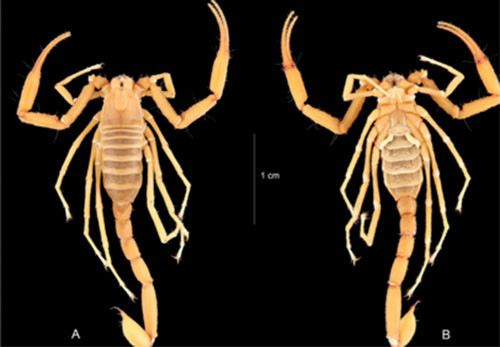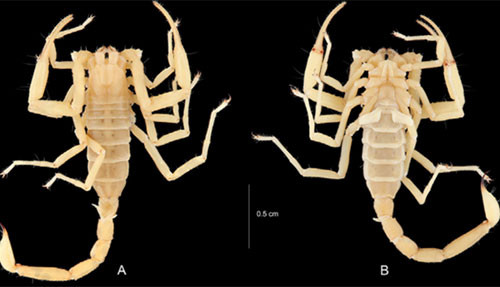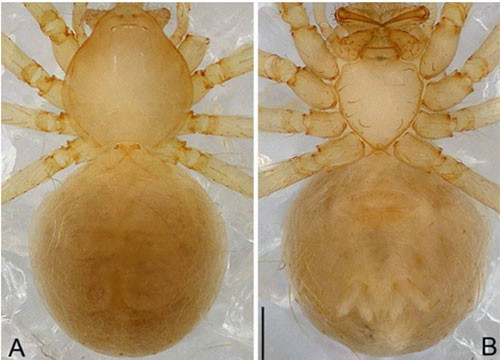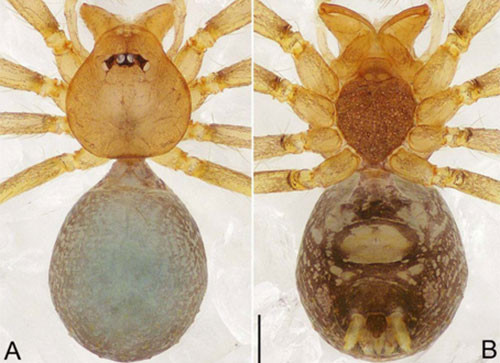Nine new invertebrate species of Vietnam
Two species of scorpion and seven species of spiders are not only of scientific value but also of high practical significance for the pharmaceutical and plant protection industries.

Associate Professor Pham Dinh Sac (Vietnam Museum of Nature, Academy of Science and Technology) and colleagues announced 9 new species in two prestigious international magazines Comptes Rendus Biologies in May and Zookeys in February this year. . In the picture is scorpion Vietbocap aurantiacus sp.nov discovered in Thien Duong cave, Phong Nha - Ke Bang National Park, Quang Binh.Their bodies are dark yellow, their stomachs burning yellowish brown.Adult female scorpion (holotype model) is 35.8mm long.(Photo: Lourenco & Pham).

Vietbocap quinquemilia sp.nov scorpion species.also in Thien Duong cave, Phong Nha - Ke Bang National Park, Quang Binh province.The scorpion is pale yellow, with many dark brown spots on the back.Adult male scorpion (25mm holotype);thoracic head armor 3mm long;2mm wide.The teeth on the structure comb 8-8 in the male scorpion and 7-7 in the scorpion.(Photo: Lourenco & Pham).

Spider species Pinelema huoyan sp.nov .discovered in Nuoc Nui cave, Phong Nha - Ke Bang National Park, Quang Binh.Species are specialized in cave environments and are endemic to Vietnam.They differ from all species of Pinelema in male traits characterized by pear-shaped, flame-shaped onion of oil lamps, U-shaped semen bags (Photo: Zhao, Pham, Song & Li).

Pinelema xiezi sp.nov spider in Tien Son cave, Phong Nha - Ke Bang National Park, Quang Binh province.This is also endemic to Vietnam.This species is different from all other species of the Pinelema genus in the characteristic pear-shaped male characteristics of the pear with the top pot, the ear-shaped form of the elephant, the bag with the warm lid.(Photos: Zhao, Pham, Song & Li).

Pinelema Spider zhenzhuang sp.nov .in Thien Duong cave, Phong Nha - Ke Bang National Park, Quang Binh province.This species is different from all other species of Pinelema in the characteristic of very long and curvature, the top of the hard and sharp onions, the hammer-shaped bag.(Photos: Zhao, Pham, Song & Li).

Pinelema laensis sp.nov Spider.in La cave, Xuan Son National Park, Phu Tho province.They differ from all species of Pinelema in male characteristics that characterize egg-shaped, larvae with streaks running along, pockets containing semen-shaped pouches.(Photos: Zhao, Pham, Song & Li).

Pinelema spider spirulata sp.nov.discovered in Lap cave, Xuan Son National Park, Phu Tho province.This species is different from all other species in the Pinelema genus in the snail-shaped trajectory, which refers to the notched elliptical shape on the head, the round-shaped bag.(Photos: Zhao, Pham, Song & Li).

Spider species Pinelema tamdaoensis sp.nov.in Tam Dao National Park, Vinh Phuc province.They differ from all other species in the Pinelema genus in males' characteristic traits characterized by teardrop-shaped, crescent-shaped onions at the end.(Photos: Zhao, Pham, Song & Li).

Spider Pinelema pacchanensis sp.nov.in Pac Chan cave, Bac Kan province.This species is specialized in the cave environment, endemic to Vietnam.They differ from all other species in the Pinelema genus in males' characteristic traits that characterize twisted tweezers in the head, pale onions, tubular vesicles.(Photos: Zhao, Pham, Song & Li).
According to Assoc., The finding is not only meaningful in science but also has high practical value. Scorpion venom is a potential natural material for the current and future pharmaceutical industry. In addition, spiders are also known as important natural enemies that contribute to the prevention of plant pests.
- Discover the secret of octopus - the sea monster
- In 2014, Vietnam discovered 126 new species
- People were born due to
- Strange species of almost 'immortal' creatures
- 2008: Discovered 26 animal species in Vietnam
- Discovering new plant species in Vietnam
- Two new turmeric species were discovered in Vietnam
- Discover a new plant species, Moc Huong
- Discovered 3 new animals in Vietnam
- Discovering many new species in Vietnam
- Discover four new lizard species in Vietnam
- Russian scientist 20 years attached to Vietnam forest
 Animal 'suffering' after hibernation
Animal 'suffering' after hibernation Why do goats climb well?
Why do goats climb well? Scientists were surprised to see chimpanzees eating turtles
Scientists were surprised to see chimpanzees eating turtles Giant catfish died deadly due to drought in Thailand
Giant catfish died deadly due to drought in Thailand